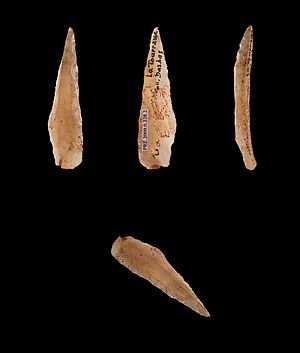Epipalaeolithic facts for kids
The Epipaleolithic (say "eh-pee-PAY-lee-oh-LITH-ick") is a cool name for a time period right after the last ice age ended. It's when people were still hunting and gathering their food, but before they started farming in the Neolithic period. Think of it as a bridge between the really old Stone Age and the New Stone Age.
Sometimes, people get the Epipaleolithic mixed up with the Mesolithic period. These two terms are often used to mean the same thing. However, if we want to be super precise, Epipaleolithic usually describes cultures that weren't changed much by the end of the Ice Age. The term Mesolithic is often saved for places like Western Europe, where the disappearance of huge animals (called Megafauna) had a big impact on people living there at the end of the Ice Age.
Contents
What Was the Epipaleolithic Period?
The Epipaleolithic period happened after the Last Glacial Maximum, which was the coldest part of the last Ice Age. As the Earth started to warm up, new environments appeared. This period is a key part of human history because it shows how people adapted to a changing world before they learned to farm.
When Did This Period Happen?
This time period generally ranges from about 20,000 to 10,000 years ago. It's a long stretch of time where humans were figuring out how to live in a world that was slowly getting warmer and wetter. This warming trend brought new plants and animals to different areas.
Life as a Hunter-Gatherer
During the Epipaleolithic, people were still hunters and gatherers. This means they moved around to find food. They hunted animals like deer and wild goats, and gathered plants, fruits, and nuts. They were very skilled at using the resources around them.
Tools of the Time
People in the Epipaleolithic made special tools. One important type of tool was the microlith. These were tiny stone blades, often just a few centimeters long. People would attach these small blades to wooden or bone handles to make tools like:
- Spears for hunting
- Arrows for bows
- Sickles for cutting plants
These tiny tools show how clever and adaptable people were. They could create more complex tools by combining different materials.
Epipaleolithic vs. Mesolithic: What's the Difference?
It's easy to confuse the Epipaleolithic and Mesolithic periods because they both happened after the Ice Age and before farming. However, there's a subtle difference, especially in how archaeologists use the terms.
Impact of the Ice Age Ending
The main difference often comes down to how much the end of the Ice Age affected the people living in a region.
- Epipaleolithic: This term is often used for areas, especially in the Near East, where the climate changes were more gradual. People could continue their hunting and gathering ways without huge disruptions.
- Mesolithic: This term is usually used for Western Europe. Here, the end of the Ice Age led to big changes. Many large animals, like mammoths, died out. This meant people had to find new ways to get food, often focusing more on fishing, smaller game, and gathering plants.
So, while both terms describe a "middle Stone Age," the Epipaleolithic often refers to places where life changed less dramatically, and the Mesolithic to places where people had to adapt more quickly to a new environment.
Images for kids
-
Microliths tools from Ein Qashish South, Jezreel Valley, Israel, Kebaran and Geometric Kebaran, ca. 23,000-16,500 BP
See also
 In Spanish: Epipaleolítico para niños
In Spanish: Epipaleolítico para niños




